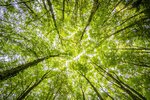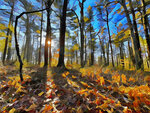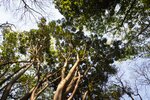





JIM BEHNKE AND KRIS MCGINN share their knowledge of and experiences with trees. Hoping that, as the trees have taught them, their story is — stronger together.
In the mid 1990s, the newly renovated playground at Masconomo Park was a big draw for local parents with kids. It seemed to have everything a kid could wish for—teeter totters, swing sets, and a spiral staircase leading to a slide back down to the mulch-covered surface of the park. Yet, after exploring these attractions, my kids often turned their attention to something less obvious.
Toward the water behind the bandstand is a row of seven yew trees planted over 100 years ago, long before anyone conceived of polyethylene playgrounds. There’s something about these trees that says to young children: “Climb me!” My kids called them, “the monkey trees,” and that memory has stayed with our family for over two decades.
Recently, I paid a visit to the monkey trees. When I inspected the base of the trees, I could see the patina left by decades of tiny feet making their first steps toward the low-hanging branches. It seems countless children have pursued their imaginations among the monkey trees. And the trees record their memories of those children, just as the children fondly remember the trees.
When I was little my absolute favorite outfit was a long sleeve, poly blend tee with a huge tree on the front and matching bell bottom pants printed with row upon row of trees. I dearly loved my little arboreal outfit and wore it when my first-grade class took a field trip to our small community library. At the back of the library, there was a room full of huge artificial trees that had little headphones and buttons on the trunks. When you put on the headphones and pushed the button, the tree would speak. And tell you its story.
Trees do speak, perhaps to us, but most certainly to one another. Unbeknownst to us, there is an entire world of tree whispering going on above our heads and below our feet. All of the time. Acacia trees speak to one another through scent. In his book, The Hidden Life of Trees, Peter Wohlleben explains how when an animal, such as a giraffe, begins to eat the leaves of an acacia, the tree emits a gas (ethylene) that alerts other trees within a 100-yard radius that it is being attacked. The neighboring trees receive the message and produce a toxin that is quickly distributed to their leaves to deter the hungry giraffes.
Trees also communicate with one another through mycorrhizal (fungal) networks. Mycelium (tiny threadlike structures) reach out from the root tips of trees and weave into the mycelium from other tree roots, allowing trees to share resources and send alerts of danger, drought, and disease. When a tree is being overtaken by aphids, for example, it sends out hormonal and electrical signals through its network. Surrounding trees receive the signals and make chemical adjustments to deter the aphids. Some trees are able to identify pests by the pest’s saliva, then create and release pheromones to summon specific beneficial predators to consume the invading pests.
On a solemn spring day in the early 1970s, the iconic American elm on Union Street across the street from the library was removed, a victim of Dutch elm disease. It was the biggest tree in town and produced an impressive amount of shade. One of the men on the removal crew that day was a young Tom Henderson. Now 79 years old, Tom has been Manchester’s tree warden for 20 years. On the day of its removal, he did a ring count; the tree was 175 years old.
Like so many towns in North America, Manchester lost most of its elms to Dutch elm disease in the span of just a few years. The disease is caused by a fungus spread by elm bark beetles. Although the pathogen most likely originated in Asia, scientists believe it was introduced to America in the late 1920s by a shipment of lumber from the Netherlands, thus the name. The American elm, native to North America, didn’t have the biological defenses to thwart this pathogen. Over 75 percent of the elms in North America succumbed to the disease.
The sudden loss of so many elms changed the physical character of Manchester. That loss inspired a group of residents to form the Friends of Manchester Trees (FOMT), a non-profit organization that has subsidized and planted trees around town over the past five decades. According to Su-Yin Mittermaier, president since 2018, FOMT has planted over 500 “commemorative trees” from private donors wishing to honor lost loved ones and well over 1,000 other trees.
There are still at least six mature American elms in town that survived the blight: next to the Singing Beach parking lot, near the intersection of Beach and Masconomo Streets, next to The Mooring restaurant, and several others up on Tuck’s Point. But my favorite American elm is hiding in plain sight on the east side of School Street just north of the four-way stop at Pleasant Street. Observant motorists may have noticed that three yellow reflectors were recently mounted on its trunk to prevent motorists from sideswiping the tree. And who put up those reflectors? Tom Henderson.
Later in life, when I had long outgrown my beloved tree pants, I took a road trip with my daughter Stella, who was nine at the time, far into Northern California to a small town on what is called The Lost Coast. Our route took us directly through the famous old-growth Humboldt redwoods. The forest felt like a cathedral. There was an undeniable presence of peace and wisdom. Here, in this very forest, from 1997 to 1999, a young woman named Julia Butterfly lived in Luna, a 180-foot-tall, 1,500-year-old coastal redwood tree, for 738 days to prevent the Pacific Lumber Company loggers from cutting it down. She succeeded and Luna still stands today. Luna is what is known as a “mother tree.”
Mother trees and their cooperative relationships have been the research focus of Suzanne Simard, a professor of forest ecology at the University of British Columbia. Her work revealed that mother trees, bigger and older, have extensive fungal networks that draw up water to send to surrounding seedlings struggling to survive. Mother trees listen for signs of distress from their family and send nutrients to their offspring most in need. Simard is currently researching kin recognition in Douglas firs. By using seedlings, Simard has shown that related pairs of trees recognize the root tips of their kin and favor them with the amount of resources they send through their fungal networks.
Neighboring trees of the same height will only grow until they encounter another tree’s branches and then stop. They respect one another’s space. They also equalize differences. Leafy birch trees send nutrients to their neighboring firs, and, in turn, when the birch has no leaves, the firs send sugar and carbon. When a tree is ill, surrounding trees will send resources. There are even instances of trees that have been cut to a stump for hundreds of years, but still have chlorophyll because they continue to be fed by surrounding trees, perhaps in hopes of bringing it back.
Anyone who’s dropped off a child at the Manchester Memorial School is familiar with the two oaks at the bottom of the driveway on Lincoln Street. The larger of these two scarlet oaks is estimated to be about 100 years old. Last summer, on the advice of its contractor, the school announced plans to remove one of the trees to make room for a sign for the new school building. According to a town bylaw, the public has an opportunity to comment on such decisions. The public commentary occurred at a Board of Selectmen meeting on August 16.
The first person to address the BOS on that Zoom call was 10-year-old Isaac Star Collins, a fourth grader at Manchester Memorial. Isaac’s interests in trees was encouraged by both the town and the school librarian, who introduced Isaac to Su-Yin Mittermaier. It was Su-Yin who suggested Isaac speak up at the BOS meeting on the fate of the scarlet oak. “Why would you kill a 100-year-old tree for a sign that you could put up somewhere else,” Isaac asked the BOS. While Isaac was not the only speaker that evening, several people commented to me that the sincerity of his statement swayed the decision in favor of saving that tree. “I felt I made a difference and I felt good about it,” Isaac told me.
Today, my road trip partner is nearly 16, and in the past five years the trees have been more important to me than ever before. I go to the forest, with my dogs, to be with the trees. And they still speak. I have found everything amongst the trees—stories, signs, safety, peace and even love.
Throughout time, in poetry, myth, art and literature, trees have always had powerful symbolism. The tree of life. The tree of knowledge. The Giving Tree. Fertility trees. The enchanted forest. Tolkien’s Treebeard. Avatar’s Tree of Souls. The Mother Tree. Again and again trees represent fundamental wisdom. Perhaps this is why we are drawn to them, as we walk among them, climb them, rest on them and are buried under them. They are wise. The trees take only what they need. They share. They understand that as Peter Wohlleben put it, “A tree is only as strong as the forest around it.” The trees try to tell us, to show us, that we are truly stronger together.
Yes, trees are biological wonders. They communicate. They live in community. They give us medicine, food, shelter and resources. They remind us of what was and what can be — they endure. And, they give us hope. The wisdom of the trees reminds us to slow down and take care of one another. As do the children, like Isaac. Let us all take time to honor the trees. To play in them like the children in the monkey trees. And most of all, let us listen to the trees. And learn.